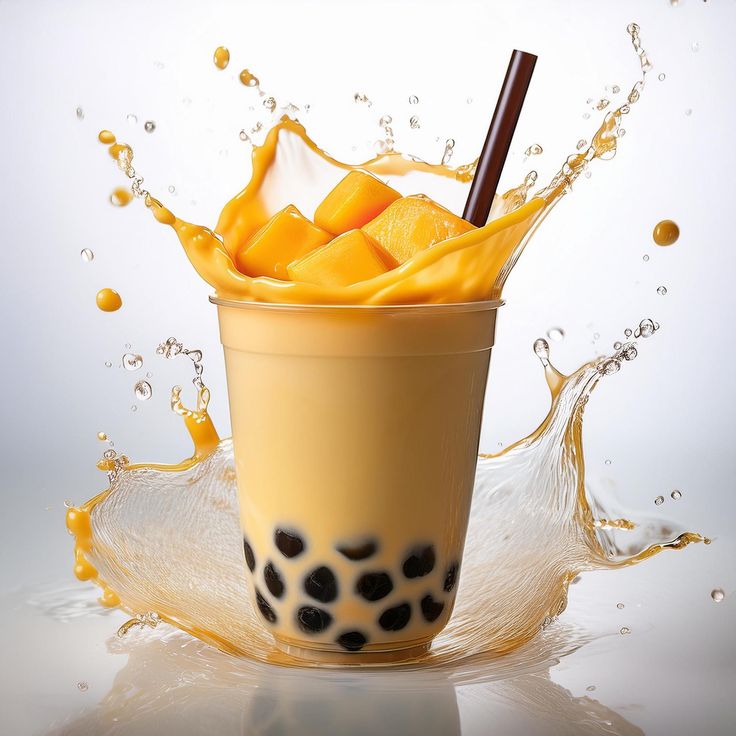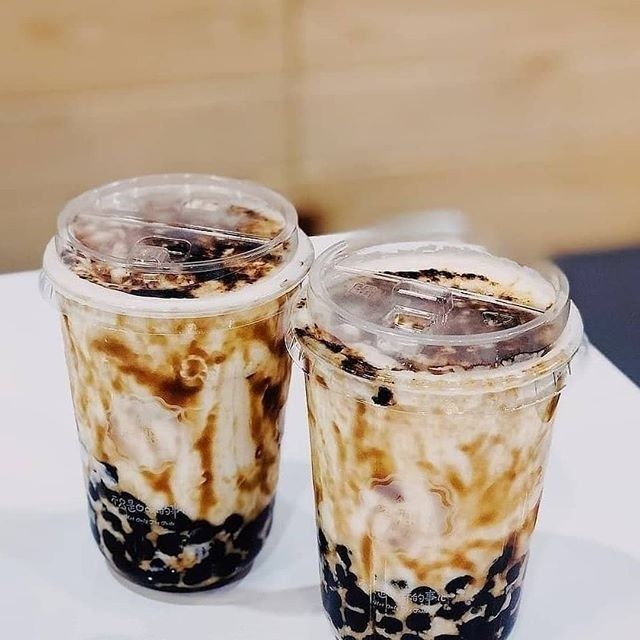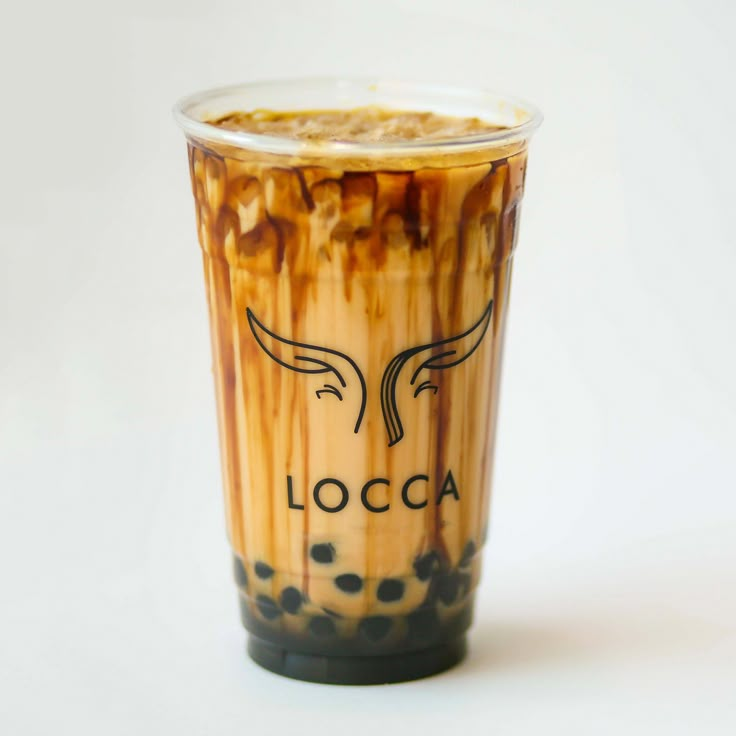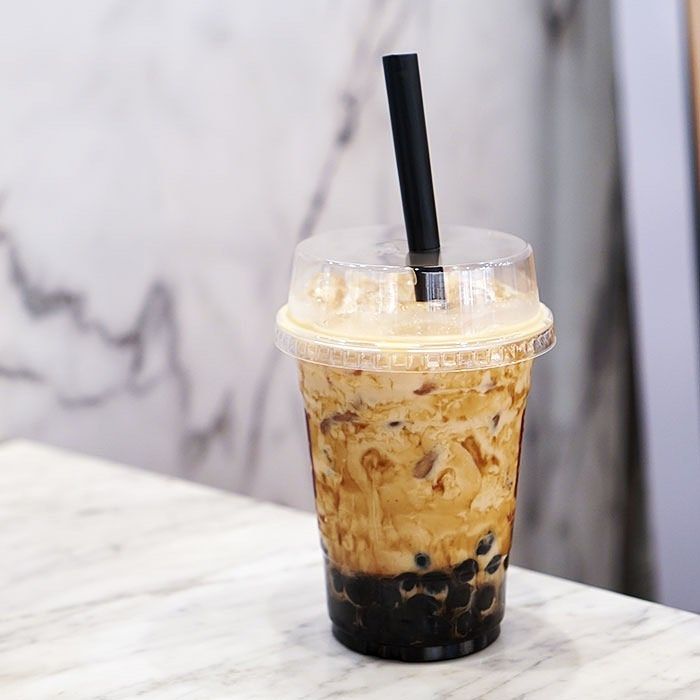History of Boba Tea
The journey of boba tea began in the 1980s, marking a significant moment in Taiwan’s food culture. This beloved beverage, known for its distinctive pearls and sweet flavors, claimed fame beyond its birthplace. As we explore its roots and expansion, we gain insight into the drink’s global allure.
Origins in Taiwan
Boba tea made its debut in Taiwan, captivating locals with its unique combination of tea, milk, and tapioca pearls. Origin stories point to the city of Taichung, with several tea shops claiming the title of inventors. What began as a fun and innovative dessert beverage turned into a cultural icon. Both teenagers and adults found joy in the chewy texture of the pearls, known as ‘boba’. The refreshing taste of tea provided a perfect balance, making boba tea an instant hit.
Spread to International Markets
The spread of boba tea to international markets started in the 1990s. Popularity surged among Asian communities abroad, initially introducing the drink to a broader audience. In time, the trend caught on with diverse populations. Major cities in the United States, Canada, Australia, and Europe now host numerous boba tea shops. This global expansion reflects the beverage’s adaptability and the universal appeal of its sweet, customizable experience. Today, boba tea stands as a worldwide phenomenon, cherished by people from various backgrounds and age groups.

Essential Ingredients of Boba Tea
Boba tea’s charm lies in its simplicity and the quality of its core components. Every cup combines distinct tastes and textures to create a beverage that offers both comfort and excitement. To ensure your homemade boba tea rivals those found in specialty shops, knowing your ingredients is key.
Tea Varieties
The tea base is the foundation of boba tea, influencing its overall flavor profile. Black tea is the classic choice, giving a strong, robust taste that pairs well with milk and sweetener. Green tea offers a lighter, more floral note, while oolong tea strikes a balance with its earthy undertones. You can explore jasmine and matcha teas too, for a fragrant or umami-rich twist.
Tapioca Pearls
Tapioca pearls, the iconic ‘boba’, are what set this beverage apart. They should be chewy yet soft, providing a pleasant contrast to the smooth tea. These pearls come from cassava root and must be cooked just right to achieve the perfect texture. Tapioca pearls vary in size, but the larger ones are best for that satisfying ‘pop’ when bitten into.
Sweeteners and Flavorings
The final touches to boba tea are the sweeteners and flavorings that create its signature taste. Popular options include honey, simple syrup, and brown sugar, each contributing a different sweetness level. Flavorings can range from fruity to creamy, with mango, taro, and coconut among the favorites. You can adjust the amounts to suit your taste, ensuring each sip meets your sweet tooth’s desires.
Making Bubble Tea at Home
Making boba tea at home brings joy and creativity to your kitchen. It allows you to experiment with flavors and create a drink tailored to your preferences. Follow our detailed guide to create this tasty beverage from the comfort of your home. With a few simple ingredients and steps, you can impress family and friends with your homemade boba tea.
Step-by-Step Preparation Guide
Begin by boiling water for your tea. Opt for your favorite variety, such as black, green, or jasmine tea. Once the water is hot, steep the tea bags or loose leaves. The usual steeping time is approximately 3-5 minutes, depending on how strong you want your tea. While the tea cools down, you can prepare the tapioca pearls. In a separate pot, bring water to a rolling boil and add the pearls slowly.
Stir the pearls gently as you add them to the boiling water. This helps prevent them from sticking together. Cook the pearls for about 20 minutes. After this time, let them sit in the hot water for a few minutes to ensure they reach the ideal chewiness. Once the pearls are ready, drain them and rinse under cold water. This step stops the cooking process and helps achieve the desired texture.
Mix the pearls with sweetener while they’re still warm. This will help the sweetener dissolve evenly and enhance their flavor. In your serving glass, pour in the cooled tea and add a generous amount of the sweetened pearls. If you like, you can also add milk to create a creamier texture. Give it a good stir, and just like that, your homemade boba tea is ready to enjoy.
Tips for Perfect Tapioca Pearls
For the best boba, focus on cooking time and the cooling process. The pearls should be soft on the inside while remaining slightly firm on the outside. Ensure you stir the pearls at the start to prevent them from sticking together. After cooking, let them soak in sugar syrup or honey for an added sweet taste, which enhances their flavor.
It’s important to use the pearls within a few hours, as they can harden over time. Lastly, don’t forget to taste the pearls before adding them to your tea. This is the best way to ensure they meet your desired texture and sweetness. Enjoy your homemade boba tea, and relish the satisfaction of creating this delightful treat from scratch!

Customizing Your Boba Tea
One of the joys of boba tea is its versatility in customization. You can easily tailor this delightful drink to suit your taste preferences and dietary needs. The beauty of boba tea lies in its countless possibilities, allowing each person to create their unique version. Let’s dive into how you can mix flavors and textures to craft your ideal boba tea concoction. By experimenting with various components, you can enjoy a different boba tea experience each time you sip.
Mixing Flavors and Textures
When customizing your boba tea, consider the flavor synergy between the tea base and added ingredients. You can achieve a perfect balance of flavors through careful mixing. Try blending different teas or adding fruit syrups to elevate your drink. For example, pairing jasmine tea with lemon syrup can provide a refreshing and fragrant twist. Similarly, combining rich black tea with strawberry purée can introduce a fruitiness that brightens the overall flavor profile.
For texture, your options extend beyond traditional tapioca pearls. You might experiment by adding flavored jelly, creamy pudding, or even chunks of fresh fruit. Each of these choices provides an additional layer of chewiness or a burst of flavor with every sip. The result is a boba tea that not only tastes great but also provides a satisfying texture.
Non-traditional Ingredients
Embrace creativity by incorporating non-traditional ingredients into your boba tea. For those seeking dairy-free alternatives, consider using oat milk, almond milk, or soy milk. These options offer a creamy texture while catering to various dietary preferences. If you’re in the mood to spice things up, think about adding hints of ginger or cinnamon, which can elevate the flavor profile remarkably.
For a healthier twist on sweetness, opt for natural sweeteners like stevia or agave nectar. These substitutions help lower the calorie count while still delivering the sweetness you crave. Exploring these alternatives not only caters to specific dietary needs but also opens up an exciting world of flavors for boba tea enthusiasts to explore. So, don’t hesitate to unleash your creativity and craft the boba tea of your dreams. Each drink can be a personal masterpiece waiting to be savored.

Best Practices for Bubble Tea Shops
To run a successful boba tea shop, adhering to best practices is vital. Quality and customer experience are the pillars of a thriving boba business. In this section, we’ll explore how to maintain these elements at high standards.
Maintaining Quality and Freshness
Freshness in ingredients is crucial for the perfect boba tea. Here’s how to ensure it:
- Use Fresh Tea Leaves: Brew tea daily using high-quality leaves. This guarantees a fresher and richer flavor.
- Cook Pearls Properly: Tapioca pearls should be soft and chewy. Cook them in small batches and keep them in a syrup solution to preserve freshness.
- Quality Control: Check all ingredients regularly for freshness. Discard anything that doesn’t meet standards.
- Proper Storage: Store non-perishable items in airtight containers to extend their shelf life.
By focusing on these areas, you can serve top-notch boba tea that keeps customers returning.
Creating a Memorable Customer Experience
A memorable experience can turn first-timers into regulars. Here are tips to delight your customers:
- Friendly Staff: Train your team to be welcoming and knowledgeable about the menu. Good service makes a lasting impression.
- Customization Options: Allow customers to tailor their drinks. Offer a variety of ingredients for personalized concoctions.
- Atmosphere: Create a comfortable and inviting space. Decor and music contribute to a pleasant environment.
- Loyalty Program: Reward repeat customers with a loyalty program. Discounts and free beverages can encourage more visits.
Combining these practices will not only satisfy customers but also foster loyalty, crucial for the long-term success of your boba tea shop.

The Health Aspect of Bubble Tea
As the popularity of boba tea continues to rise, so does the interest in its health effects. While there’s no denying the delight that a glass of boba can bring, it’s important for enthusiasts to understand the nutritional content and to consider making healthier choices when indulging in this sweet treat.
Nutritional Information
Boba tea’s base typically consists of tea, tapioca pearls, milk, and sweetener. Here’s a breakdown:
- Calories: A standard boba tea can range from 200 to 450 calories, depending on the size and ingredients used.
- Sugar: High sugar content is common, with some drinks containing over 50 grams.
- Carbohydrates: Tapioca pearls contribute to a high carb count, offering minimal nutritional value.
- Dairy: Milk or creamer can add fats and additional calories to the beverage.
It’s clear that while boba tea can be a fun treat, it’s often high in sugars and calories, which should be consumed in moderation as part of a balanced diet.
Choosing Healthier Options
For those who love boba tea but want to keep health in check, here are some smart choices:
- Less Sugar: Opt for half or no sugar levels when you order. Many shops offer sugar-level customization.
- Alternative Milks: Choose almond, oat, or soy milk for a lower-calorie option with less saturated fat.
- Portion Control: Go for a smaller size to cut down on calorie and sugar intake.
- Tapioca Alternatives: Try grass jelly or fruit pieces instead of tapioca pearls for a lighter and more nutritious option.
Incorporating these tips into your boba tea routine can help make this beloved beverage a healthier part of your diet. By being mindful of the nutritional information and opting for healthier alternatives, you can enjoy boba tea without compromising on wellness.

Bubble Tea Trends and Innovations
The world of boba tea is ever-evolving, with new trends and innovations constantly emerging. Staying ahead of these trends is key for enthusiasts and shop owners alike to keep the boba tea experience exciting and fresh. Let’s delve into some of the latest developments in the boba tea scene.
Seasonal Specials
Creative boba tea shops are now offering seasonal specials, attracting customers with limited-time flavors that complement the time of year. Here are a few approaches:
- Summer Coolers: Think refreshing flavors like watermelon, peach, or cucumber during hot months.
- Fall Spices: As the weather cools, spices like pumpkin, cinnamon, and nutmeg warm the soul.
- Winter Blends: Rich, creamy flavors such as chocolate or peppermint make cozy winter treats.
- Spring Refreshers: Floral and fruity teas, like cherry blossom or strawberry, welcome the springtime.
These specials not only bring variety to the menu but also create a buzz that can boost sales and customer interest.
New Boba Variations
Innovation in boba tea is not just about flavors, but also about new forms and experiences. Below are some of the cutting-edge variations:
- Cheese Tea Boba: A savory-sweet combination topped with a creamy cheese foam.
- Boba Coffee: Combining the appeal of coffee with chewy pearls to kickstart the day.
- Vegan Boba: Dairy-free and plant-based alternatives to cater to all dietary preferences.
- Bubble Waffles: A playful dessert where boba is served with a sweet, egg-based waffle.
By adopting these trends and continually innovating, boba tea remains a dynamic and much-loved addition to global beverage culture.